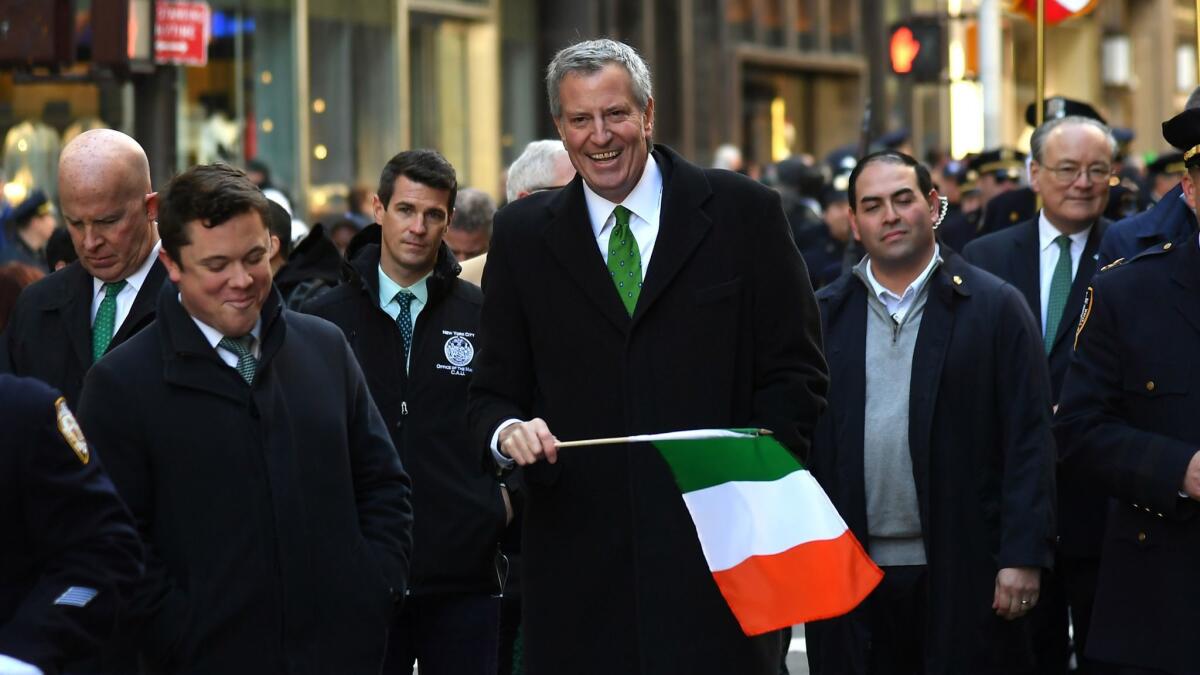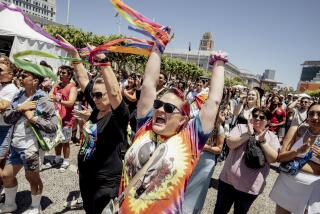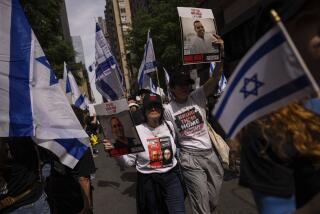Irish pride — and a dash of politics — at largest St. Patrick’s Day parade in U.S.

- Share via
Reporting from NEW YORK — A new, troublesome topic hovered over the St. Patrick’s Day parade in New York this year: Britain’s failed Brexit deal with the European Union that could squeeze Ireland’s economy.
But nothing could put a damper on the largest American celebration of Irish heritage on Saturday, with tens of thousands of marchers following a painted green line up Fifth Avenue for the six-hour procession.
Kevin Coughlan, a 27-year-old spectator wearing pants with four-leaf clovers, captured both the New York celebration and the political turmoil overseas, where he still has plenty of family — in Ireland.
“I’ve always been so proud to be an Irish American, and that’s what today is about; it’s more than just one big party, it’s about celebrating our freedom,” said the Hoboken, N.J., resident.
His mood darkened when he turned to Brexit, which “is definitely something we’re all worried about, especially my family,” he said. “I mean, we’re all sort of just waiting for the shoe to drop to see what this means for the Irish economy.”
But, he added, “We can get through anything; we survived a potato famine.”
Through its history, dating back more than 250 years, the New York parade has often had a political element. In the 1970s and ’80s, as sectarian violence flared in Northern Ireland, there were controversies over the inclusion of groups supporting the militant wing of the Irish Republican Army. A banner reading “England get out of Ireland” has flown in the parade since the 1940s.
This year’s march took place amid a new set of questions about relations between the United Kingdom and Ireland.
“When the Irish take to the streets this Saturday for the 258th St. Patrick’s Day Parade, our thoughts will take us far beyond the festivities on Fifth Ave. to Washington, D.C., and to the British Parliament in London,” the grand marshal of this year’s parade in Manhattan, attorney Brian O’Dwyer, wrote in an editorial in the New York Daily News this week.
British lawmakers are struggling to find a way to exit the European Union without disrupting the two-decade-old peace accords that created an open border between the Republic of Ireland, which is in the EU, and Northern Ireland, which is in the U.K.
This week, with a March 29 deadline looming, British lawmakers voted to seek to delay Brexit for at least three months. But the possibility exists that the line between the two parts of Ireland, which has been unguarded for 20 years, will once again become hardened with vehicle checkpoints, trade rules and tariffs.
O’Dwyer said Irish Americans are ready to mobilize politically to oppose any arrangement that leads to a restoration of the hard border that once split the Emerald Isle.
“It was Irish American activists who pressured former President Bill Clinton, over the objections of London and the U.S. State Department, to grant a visa to Sinn Fein’s Gerry Adams that set in motion the process that led to the Good Friday Agreement, which ended the sectarian violence known as the Troubles and opened the border between the two Irelands for the first time since partition at the time of Irish Independence in 1921,” he wrote. “We have been talking to leaders on both sides of the Atlantic to let them know that the same Irish American activists who pressured the Clinton administration are ready to saddle up again and fight against a post-Brexit trade deal between the U.S. and Great Britain if a hard border is restored.”
But for most at Saturday’s parade, the political debate over the future Northern Ireland took a backseat to the pageantry.
Popular marching groups included the pipe and drums corps from the Emerald Societies of the New York police and fire departments and the 1st Battalion, 69th Infantry Regiment, of the New York Army National Guard, which has led off the parade since 1851.
The parade was held on Saturday because St. Patrick’s Day, March 17, is on a Sunday this year.
More to Read
Sign up for Essential California
The most important California stories and recommendations in your inbox every morning.
You may occasionally receive promotional content from the Los Angeles Times.










